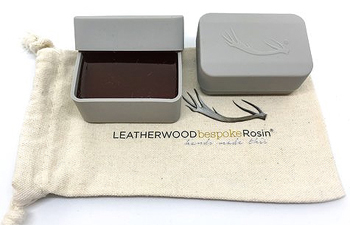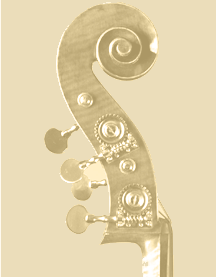 |
 |
Home |
 |
 |
Bass Café |
 |
 |
Giovani Battista Rogeri Basses
(Italian model, $4950) |
 |
 |
Wan-Bernadel Deluxe Basses
(French model, $4950) |
 |
 |
Basses Under $3,000: Thompson Plywoods, Hybrids, Emile
Gillet, starting at $1,485 |
 |
 |
Bass Bows |
 |
 |
Upright Bass Strings |
 |
 |
Bass Sheet Music, Methods
& Etude Books |
 |
 |
Bass CD / DVDs |
 |
 |
Bass Accessories (Rosin, Pickups, Metronomes, Tuners, Amps
etc...) |
 |
 |
Bass Covers & Bow Cases |
 |
 |
Bass Flight Cases |
 |
 |
Bass Teacher Directory |
 |
 |
Cellos |
 |
 |
Violin, Viola & Cello Cases |
 |
 |
Gift Certificates |
 |
 |
About
Us |
 |
 |
Contact Us |
 |
|
|
|
| |
|
Leatherwood Bespoke Bass RosinThis is the
new Leatherwood bass rosin that came out in June,
2019. This rosin comes in a different format, where for $67 you get two cakes that you choose out of 5
different hardnesses: 20%, 30%, 40%, 50% and 60%. The the lower the
percentage of (resin), the harder it will be. So, 20% is the
hardest, with the absolute softest here being 60%. This is really
nothing new in the bass rosin world, as Kolstein has offered All
Weather (middle of the road) , and soft for decades. Here, there's
a range of 5. The Leatherwood people call it their "Amber
Range" (good marketing :) They are calling it
"Bespoke" (like a personal tailored suit) that can be tailored by
the player's choices and how they blend them together.
format, where for $67 you get two cakes that you choose out of 5
different hardnesses: 20%, 30%, 40%, 50% and 60%. The the lower the
percentage of (resin), the harder it will be. So, 20% is the
hardest, with the absolute softest here being 60%. This is really
nothing new in the bass rosin world, as Kolstein has offered All
Weather (middle of the road) , and soft for decades. Here, there's
a range of 5. The Leatherwood people call it their "Amber
Range" (good marketing :) They are calling it
"Bespoke" (like a personal tailored suit) that can be tailored by
the player's choices and how they blend them together.
Which ones should you choose? To help you decide
which consistency of hardness will work best, one should first
consider what type of climate(s) you live. If say, you live in
Chicago where it is cold and dry in the winter and then often hot
and humid in the summer, chances are just one type of rosin, won't
be adequate. In the cold air winters, the temperature and humidity
around the room might dictate that you use a soft type rosin:
Pop's or
Kolstein Soft.
Here with the new Leatherwood, one actually gets to select TWO
rosins. (You can select two of the same, two close together in
thickness, or two with a range in between. For instance, you can
order a 30% cake for the summer hot months and then a 50% cake for
the winter. You can mix the two rosins together which is what
professional symphony players tend to do right when the seasons
change. Where the one rosin might not be working as it did the week
before and now needs a different type of consistancy. Again, going
changing into the colder winter months, might require a softer type
rosin. Going back into summer, might require something a little
less soft and a little harder.
You often hear about bass
players that keep cello or violin rosin (because they are harder)
for when they are playing or working on just solo material: A bow
with a lot of super heavy and sticky rosin on it, while it might be
GREAT for orchestra, might also tend to cover up the some of the
partials or tone from a bass by smothering the string and blocking
the higher partials that get watered down with too much rosin. (The
rosin coated in and on the bow hair and on the string) sometimes can
take a little nuanced 'edge' away from and cloud the tone. It
really boils down to trial and error.
To simplify things a bit. The softer rosin
will be used more in orchestra type settings, where you need the
most volume and will need to grab the string with the most power.
The harder rosins in the range, will help your tone sound a little
cleaner and because you won't need to saw your bass in half (like in
orchestra), the harder version work more for solo playing. Again,
by using two rosins, you can blend the two together using more or
less of whichever one gets you closest to your desired use and/or
sound.
Again, you can pick
any
2 rosins below:
|
|


